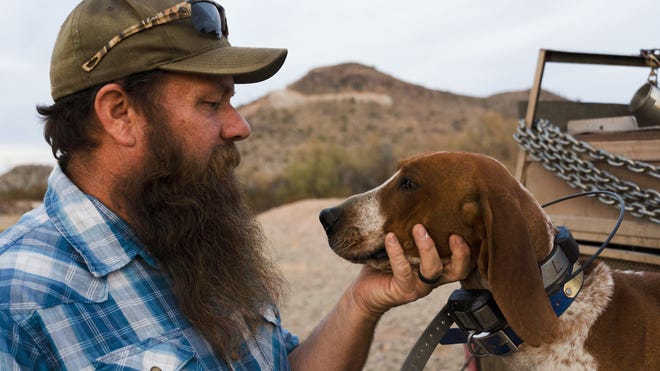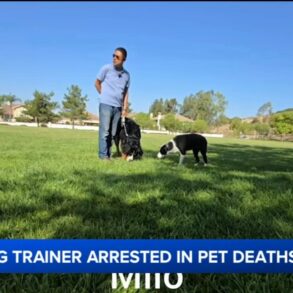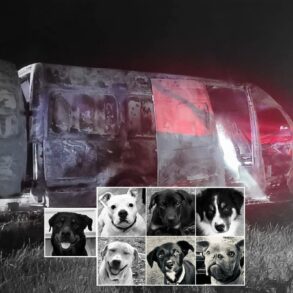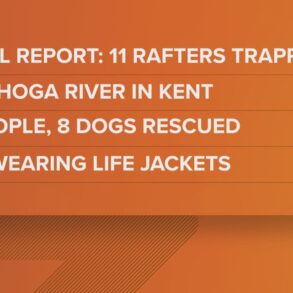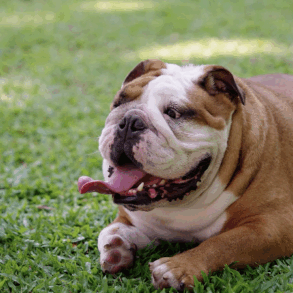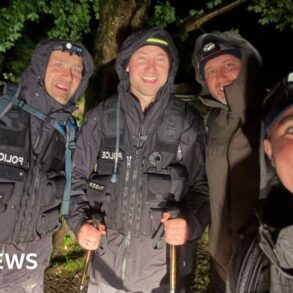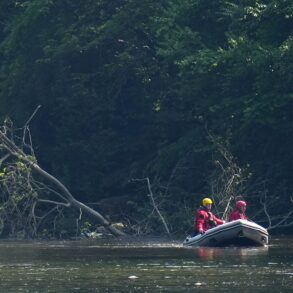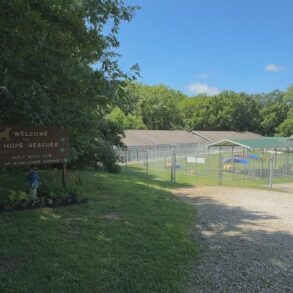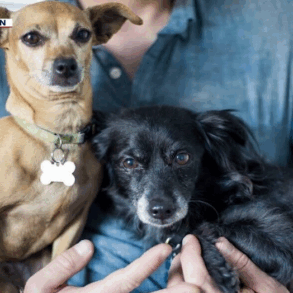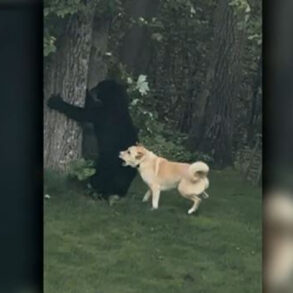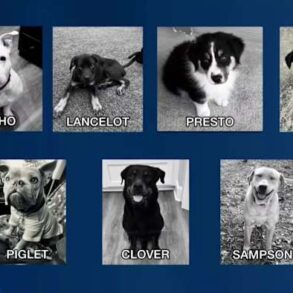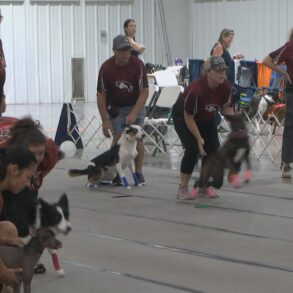In the early December light, the Arizona Game and Fish Commission meeting room filled with people wearing camouflage clothing and cowboy hats. Hunters from all over the region had traveled to north Phoenix to express their opinions about an issue raised a week earlier.
The Center for Biological Diversity had submitted a petition that questioned the ethics of sport hunting with hounds using GPS collars and its impact on endangered jaguars, ocelots and Mexican gray wolves.
The petition was not an official agenda item, but over 60 hunters signed in to talk about it, filling the hours set aside for public comment with personal stories of hunting with their beloved dogs. They spoke about the practice’s role in wildlife population management and their fears that a ban would be a step toward an outright prohibition on hunting.
Hunters asked commission members to consider conservation science over what they saw as emotional pleas outlined by the wildlife advocates, and some even brought their children to recite prepared statements at the podium about the tradition of hunting with hounds.
“I don’t have any doubt that the commission will do their job to protect Arizonans’ best interest in conservation and wildlife management. So my message here today is more for the groups that have brought forth the petition,” said Chris Watson, founder of the Arizona Working Dogs Alliance, whose children also spoke at the meeting. “Arizona sportsmen know what is coming and who is bringing it. And I’m here to warn those that are bringing it, we are not just one sportsman anymore. We are many.”
Commonly used for sport hunting mountain lions and black bears in Arizona, hunting dogs have a long tradition in the state. The center’s petition captures an inflection point between hunters and wildlife activists, raising questions over the ethics of fair chase amid technological advances.
For those who support the petition, including groups like the Mountain Lion Foundation, Wildlife for All, the Sierra Club Grand Canyon Chapter and Lobos of the Southwest, the facts seemed clear.
The 17-page document outlined the negative impact hunting dogs have on endangered species in Arizona, like jaguar, ocelots and Mexican gray wolves, including health effects from the physical stress during pursuit and the abandonment of habitat and offspring.
Wolf advocates warn:Plan to capture Mexican gray wolves near Grand Canyon may violate law
According to the petition, “the use of hounds to hunt mammals requires that the dogs roam far away from the hunter and is more likely to result in the harassment, injury, and death of non-target wildlife, including rare and protected species.”
The petition pointed to the use of GPS tracking collars worn by hunting dogs as an unfair tool when hunting big game.
“Using hounds to hunt lions, bears and other species is inconsistent with the notion of fair chase. I think it’s unethical,” D.J. Schubert, a wildlife biologist, said in an interview. Schubert is the vice president of the Animal Defense League of Arizona, a group that supports the petition. “And the fact that often, particularly for bear and mountain lion hunters, they use hounds that are equipped with radio collars. It gives a distinct advantage to the hunter and not the hunted.”
Aimed at the practice of using dogs for the sport hunting of mountain lions, bears, and other mammals, the petition does not call for the ban of hounds for hunting game birds, waterfowl, or depredation permits targeting specifically identified predators.
Despite this, hunting advocates at the commission meeting spoke out against the petition, claiming it was the first step toward further action against all hunting dogs.
“We want to point out that kind of regulation has far-reaching effects,” said Jonathan McKinney, the vice president of the Arizona Falconers Association. “So although today it’s mountain lions and bears, we as falconers use dogs to pursue rabbits and squirrels and many other things, and that would significantly affect our hunting and the way that our sport works. It is critical to have dogs.”
A week after the meeting, on Dec. 13, the Arizona Game and Fish Department informed the center that the petition did not meet a technical requirement in the administrative code and would not be considered further without revision.
As wildlife conservation groups prepare to resubmit the petition in the coming months, Arizona’s hunting community is organizing.
Hounds in jaguar country
The morning years ago that Kelly Glenn-Kimbro hit the trail with her hunting dogs and her father in the Peloncillo Mountains, she thought she was following a large male mountain lion. Her dog raced ahead, and what lay at the end of the track left her in shock.
“My dog that I had with me hit that track, and I didn’t ever imagine it was a jaguar,” said Glenn-Kimbro, reminiscing on that 1996 morning.
Her father, Warner Glenn, famously captured the first photos of a wild jaguar in the United States that day. In 2006, he came across another jaguar in the Animas Mountains in New Mexico. His hounds were there, too.
Glenn-Kimbro is a fifth-generation rancher in southeastern Arizona working the same land her family homesteaded in 1896. Her grandfather began hunting mountain lions in 1937 for predator management in the region, and the practice became a family tradition.
“My dad and grandpa hunted as guides and for predator management for years. When I was a little girl, I grew up in it,” said Glenn-Kimbro. “When I was 17, I started hunting with them and started being a houndsperson.”
Hounding is the use of dogs to track and trap game by either cornering or exhausting the target animal or forcing it up a tree. Hunters typically follow the dogs at a distance and will either kill the animal or remove the hounds and allow the animal to escape.
In Arizona, hounds can be used when hunting mountain lions, bears and a variety of small mammals, and the Arizona Game and Fish Department does not require hunters to obtain any special license or permit to use their dogs.
Hunters like Glenn-Kimbro say the use of dogs gives hunters a “decision to harvest.” While the animal is cornered, hunters can take time to estimate the age of the animal and determine the sex, then decide whether to kill or release.
Wildlife advocates argue that the use of hounds for hunting on habitat shared by jaguars, ocelots and Mexican gray wolves is a violation of the Endangered Species Act and that even the presence of hunting dogs running unleashed on the landscape has the potential to harm protected species.
Mexican gray wolves:Feds say Mexican gray wolf recovery is on track, but advocates see ‘significant setbacks’
In a 2021 memo from the University of Arizona jaguar and ocelot monitoring project to the Arizona Game and Fish Department, researchers expressed concern over “the stress and harassment caused to the jaguar” posed by the high number of hunting dogs in the Chiricahua Mountains in southeastern Arizona.
Through trail camera data and analysis, the researchers concluded that the presence of dogs impacted the areas where mountain lions and jaguars roamed.
The jaguar that researchers had been tracking in the Chiricahuas went undetected for six months, between December 2018 and June 2019, according to the memo. This was the largest gap in detection and coincided with the months that unleashed hounds were also on the landscape.
The Center for Biological Diversity has documented six jaguars that have been pursued by dogs, abandoned preferred habitat or reportedly killed in connection with mountain lion hunting in Arizona and northern Mexico in the past 30 years.
The petition warns of mistaken identity, that hunting dogs could mistake an endangered Mexican gray wolf for a coyote or an endangered ocelot for a bobcat.
During an incident in 2011 documented by the Arizona Game and Fish Department, a young hound escaped from a fenced area and chased an ocelot up a tree in the Huachuca Mountains. The owner of the dog, Tom Beatty Jr., said he’s treed an ocelot with his dogs almost yearly since that first incident.
“It’s a cat, and they go for bobcats,” said Beatty Jr., “They would probably chase house cats too.”
Beatty Jr. points to the fact that he’s caught the same ocelot year after year as proof that the presence of dogs is not causing the ocelot to abandon preferred habitat. Still, Russ McSpadden, the author of the center’s petition, believes that the pursuit of the ocelot by the dogs constitutes harassment that violates federal law.
“All these animals are protected under the Endangered Species Act,” said McSpadden, the center’s southwest advocate. “Allowing dog packs to roam in habitat where endangered species are going to exist, or critical habitat that was set aside specifically for their survival and recovery, undermines the whole process.”
GPS collars, ‘fair chase’ and technical advantages
Five hounds sit in the bed of Chris Watson’s truck as he navigated the dusty backcountry roads near Maricopa, where he grew up. Watson has been breeding and training hounds for around 20 years, and recently founded the Arizona Working Dog Alliance, a group that advocates for the rights of hunters using dogs.
Stopping near a dried up pond, he released the dogs one at a time calling them by name: Cecelia, Morozhenoe, Helado, Yucky, and Dirty.
Wearing brightly colored collars with antennas around their necks, the dogs sprinted off wildly into the desert sniffing the area for something to chase. As they ran, Watson checked his GPS tracker to follow their movements. When they get too far to hear his call, he presses a button on the handheld tracker. A tone rings from the collars, signaling for the dogs to return.
“We use GPS, yes. But we don’t track wildlife with it.” said Watson, in response to criticism over the use of tracking collars. “All that GPS does is make it easier for us to keep track of our dogs.”
The Arizona Game and Fish Department defines fair chase on its website as “the ethical, sportsmanlike and lawful pursuit and taking of free-range wildlife in a manner that does not give a hunter or an angler improper or unfair advantage over such wildlife.”
Under “fair chase,” the commission has a history of banning new technology for hunting, including smart rifles, drones and trail cameras. As the use of GPS collars on dogs becomes more mainstream and tracking technology becomes better, wildlife advocates argue that hunters are gaining an unfair advantage.
“These hounds can roam for miles and hunters can be five, 10 miles back. It’s easy tracking on their smartphone,” said McSpadden. “They can see 20 of their dogs on there and they can be pinged and alerted when the dogs have stopped because presumably they’ve treed or cornered whatever it is they were chasing. And this creates really some huge risks for federally protected species.”
At the Arizona Game and Fish Commission meeting, the hunters spoke out about the technology as a necessary tool to make certain their dogs didn’t roam onto private land and to ensure the dogs’ safety.
“They are just a tool to help us recover dogs,” said Dustin Clark at the Commission meeting in December. Clark, a recent Arizona transplant and hunter from Utah, owns a hound-themed clothing brand called Coldstrike Gear and also sells Garmin GPS collars.
“I know that I don’t have to explain to my little child that I couldn’t bring their dog home because they didn’t have a GPS collar on it,” he said. “It helps me bring all those dogs home safe.”
The future of hounding in Arizona
The use of hounds for hunting mountain lions and black bears is prevalent in Arizona. According to data collected by Arizona Game and Fish, of the 286 mountain lions killed by hunters in 2023, some 67% were hunted using dogs. The largest portion of mountain lion harvests occurred in the management zone where jaguars have also been sighted in southern Arizona.
The data does not include hunters who went out with dogs and didn’t catch anything or those who only used dogs to pursue big game.
Hunting regulations vary from state to state, and there is no consensus on the use of hunting dogs.
Ballot initiatives that banned the use of hounds passed in both Oregon and Washington, and California has banned the recreational hunting of mountain lions since 1990. Of the 34 states that allow bear hunting, only 17 permit the use of dogs, according to the petition.
Bears released in Arizona:Mother bear and cub released back into the wild after capture in Crown King
A Colorado ballot initiative, Proposition 127, would have banned the trophy hunting of mountain lions, bobcats or lynx, but it failed in November, earning only 45% of voter support.
Some Arizona hunters expressed concern that the petition from the Center for Biological Diversity was an indicator that a ballot initiative calling for a ban could be organized in the state.
Kelly Glenn-Kimbro is worried that the rise in graphic social media posts could damage public opinion in hunting with hounds.
“Disturbing videos of hound dogs tearing apart wildlife are commonplace on social media,” states the petition. It only takes a quick search to find videos of mountain lions clawing at bloodied hounds, or dogs wildly barking and biting at injured wildlife as the hunter films close by.
“There’s way too much of the killing on social media, and that doesn’t look good to anybody,” said Glenn-Kimbro, “They want to brag on their dogs because they caught a lion, that’s fine. Let them show the dog bark and tree it, and then shut the dang phone off.”
Although the petition has been denied based on a technicality in the Game and Fish Department’s rulebook, wildlife activists plan to resubmit in the coming months.
“We need a common sense conversation about what Arizonans believe constitutes reasonable, ethical and sustainable hunting,” said McSpadden, in a written statement.
“Do we think hunters unleashing packs of tracking dogs linked to satellites to overwhelm mountain lions and bears is compatible with fair chase? Are we willing to risk Arizona’s wild heritage, including the recovery of jaguars, ocelots, and Mexican wolves, so that wealthy trophy hunters can get their photo with a dead lion? For me the answer is clear.”
John Leos covers environmental issues for The Arizona Republic and azcentral. Send tips or questions to john.leos@arizonarepublic.com.
Environmental coverage on azcentral.com and in The Arizona Republic is supported by a grant from the Nina Mason Pulliam Charitable Trust.
Sign up for AZ Climate, our weekly environment newsletter, and follow The Republic environmental reporting team at environment.azcentral.com and @azcenvironment on Facebook and Instagram.
This post was originally published on this site be sure to check out more of their content.




